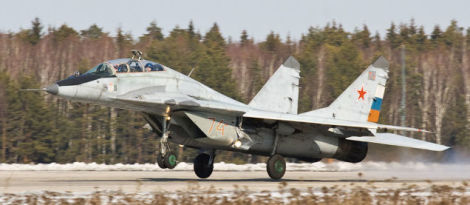Welcome to This Date in Aviation History, getting of you caught up on milestones, important historical events and people in aviation from October 3 through October 6.
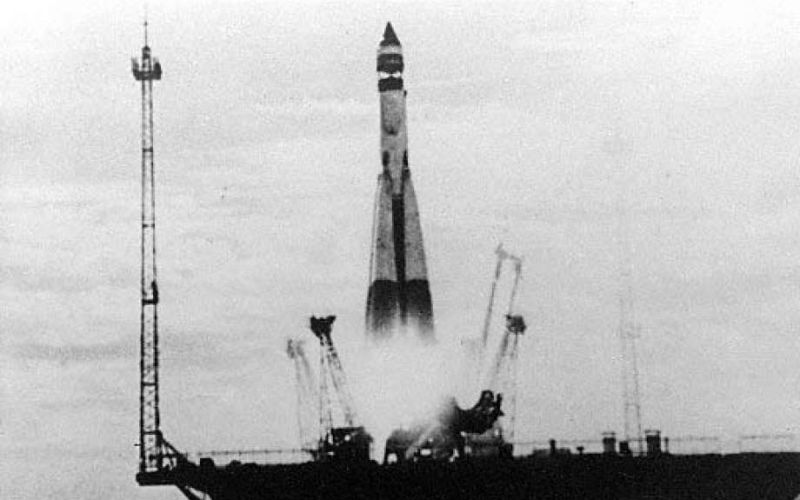
October 4, 1957 – The launch of Sputnik 1. The eighteen-month period from July 1, 1957 to December 31, 1958 was celebrated as the International Geophysical Year (IGY). Sixty-seven countries (but not China, who chose not to participate in protest of the inclusion of Taiwan) attempted to transcend the political and cultural divides of the Cold War and come together in the name of science. The ideological adversaries worked on projects that covered 11 Earth sciences, including ionospheric physics and other investigations into the near space around our planet. Despite the amicable intentions of the IGY, the Soviet Union saw the event as the perfect opportunity to make a Cold War propaganda statement by launching the world’s first artificial satellite into space, Sputnik 1 (Sputnik simply means satellite). For a generation brought up on stories of space adventure and the marvels of science fiction, Sputnik was science reality, and the American public was dismayed that the Russians had beaten the US into space.

Sputnik 1 launched into orbit from what is now known as the Baikonur Cosmodrome in Kazakhstan atop the Sputnik rocket, which the Soviets derived from the world’s first intercontinental ballistic missile (ICBM), the R-7 Semyorka. Just 24 inches in diameter, the diminutive satellite trailed four antennas placed equally around the satellite so that it could transmit to Earth from any position in its axial rotation. As the satellite circled the Earth, it emitted radio pulses that could be tracked by amateur radio operators on the ground the world over, serving as a constant reminder that the Soviets were directly overhead. Sputnik 1 could also be seen from the Earth, and observers who turned their binoculars or telescopes skyward could watch the bright dot of the Russian satellite as it passed overhead.

As effective as Sputnik 1 was as a propaganda tool, it was more than just that. The satellite also performed useful scientific experiments as it moved through the edge of space. The drag it experienced helped to ascertain the density of the upper atmosphere, and the radio signals sent back to Earth provided useful information about the ionosphere. Those radio signals lasted for 21 days before the three silver-zinc batteries ran out, and Sputnik 1 burned up on re-entry into the Earth’s atmosphere on January 4, 1958, just three days after the US launched their own satellite, Explorer 1. However, the Americans only managed a third place finish in the first heat of the Space Race, as the Russians had launched Sputnik 2 two months earlier.
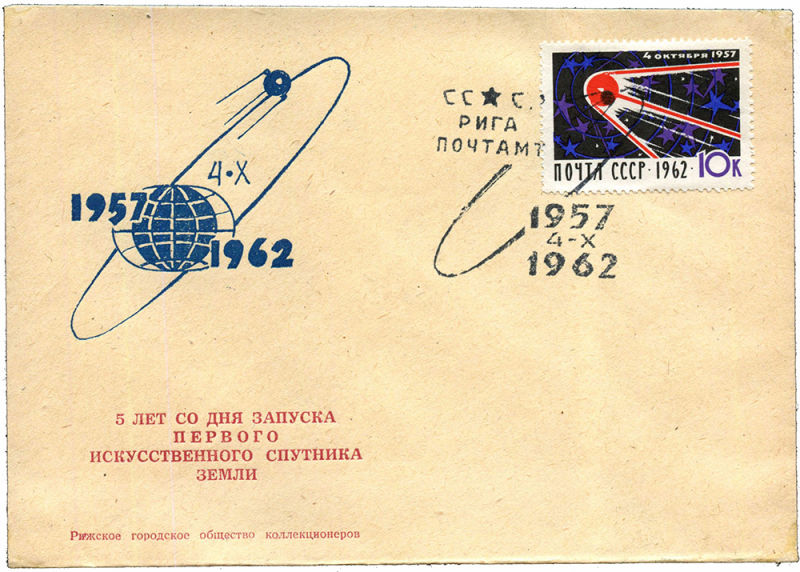
Despite the intention of the IGY to bring nations together, the launch of Sputnik 1 marked the beginning of the Space Race, an entirely new competition between East and West, with America seemingly always one step behind. It was not until the Apollo program put a man on the Moon on July 24, 1969 that the Americans finally gained the upper hand. In the face of this momentous achievement, the Russians simply shrugged and said they never wanted to go to the Moon anyway, though they had certainly tried. Instead, the Soviet space program focused its efforts on long endurance missions in orbiting space stations.
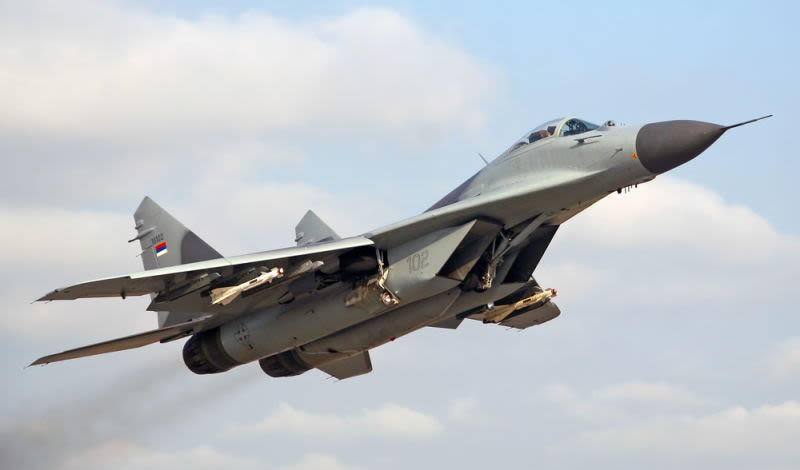
October 6, 1977 – The first flight of the Mikoyan Gurevich MiG-29. During the Vietnam War, the US Air Force discovered that using high speed fighter aircraft in the ground attack role left them vulnerable to attack from above. Air superiority became the watchword, as the US sought to take control of the airspace over the battlefield and dominate it in the same way they had late in WWII, and again during the Korean War. In the 1960s, the Air Force began its F-X program to develop a new air superiority fighter. That competition brought about the superb McDonnell Douglas F-15 Eagle, which was awarded a production contract in 1969 and took its maiden flight in July 1972. But the arms race being what it was, and still is, the Soviet Union had to trespond to the threat posed by this new high-performance American fighter. They began their own program in 1969 to produce a new frontline air superiority fighter to counter the Eagle.
Dubbed Perspektivnyy Frontovoy Istrebitel (PFI, or Advanced Frontline Fighter), the program called for an agile, long-range fighter with Mach 2+ speed and the ability to operate from rough or unimproved airstrips. But as development progressed, the Russians found themselves in a similar situation as the Americans, needing both a heavy air superiority fighter and a lighter multi-role fighter. Thus, the MiG-29 became roughly analogous to the General Dynamics F-16, while the larger and heavier Sukhoi Su-27 took on the role of the heavy fighter.
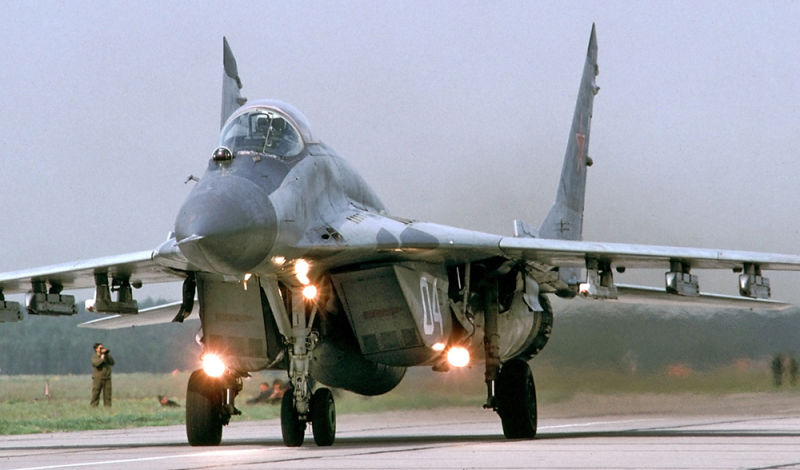
The MiG-29 is powered by a pair of Klimov RD-33 afterburning turbofans spaced far enough apart that the area between them produces additional lift. The air intake are fitted with flaps that can be closed to prevent the ingestion of foreign object debris during landing and takeoff from unpaved airstrips. Vents in the top of the fuselage then open to provide air to the engines. The MiG-29 is armed with a single 30mm cannon in the wing root, and is also fitted with a laser rangefinder and infra-red search and track (IRST) system housed in an eyeball-like bubble forward of the cockpit. This system allows the pilot to track targets that emit infrared radiation while not giving off any energy of its own, making it difficult for the target aircraft to know they are being tracked. Numerous missiles, rockets, and bombs can also be fitted to the MiG-29's six underwing hard points.
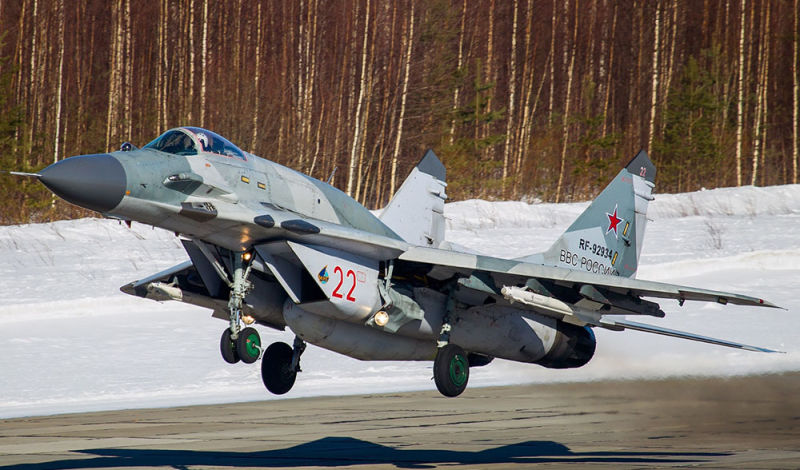
The MiG-29 entered service with the Soviet frontline forces in 1982 and was given the NATO designation Fulcrum. By the mid-1980s, the MiG-29 began appearing at international air shows, but the capabilities of the Fulcrum remained a mystery to the West until analysts and pilots were able to fly a number of them following the reunification of Germany in 1990. In 1997, the US bought Moldova’s stock of 21 MiG-29s to prevent their sale to Iran or other rogue states, and the purchase had the added benefit of providing an opportunity to train head to head against the Fulcrum. Western analysts found the Fulcrum to be a capable dogfighter, notable for its helmet-mounted sight that could target an air-to-air missile while the aircraft’s nose was pointed in another direction. But it also had a relatively short range and a somewhat primitive cockpit that limited the pilot’s situational awareness of the battle space. Like most Russian warplanes, the Fulcrum has been continuously updated throughout its service life and exists in a myriad of variants, including two-seat training variants, an export version, a carrier-capable variant, as well as a substantially modernized MiG-35 variant. Over 1,600 aircraft have been produced, and the MiG-29 continues to serve the air forces of 26 nations.
Short Takeoff
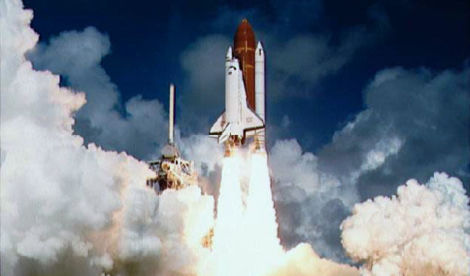
October 3, 1985 – The first flight of the Space Shuttle Atlantis, the fourth of five Space Shuttles built for NASA. The orbiter’s first mission, STS-51-J, launched on October 3, 1987, and delivered a classified Department of Defense payload to orbit before returning to Earth four days later. Atlantis was also the last Shuttle to launch into orbit on STS-135, July 8, 2011, after the cancelation of the Space Shuttle Program. Over the course of 33 flights, Atlantis racked up 4,848 orbits of the Earth, flew nearly 126 million miles, carried 156 different astronauts to space, and performed the fourth and final servicing mission to the Hubble Space Telescope. Atlantis is now on display at the Kennedy Space Center Visitor Complex in Florida.

October 3, 1943 – The first launch of the V-2 rocket, a gyroscopically guided “vengeance weapon” developed by German rocket scientist Werner von Braun. The test launch, and many following operational launches, took place from Peenemünde on the island of Usedom in the Baltic Sea. The first rocket traveled just 118 miles, but it was the precursor to more than 1,100 rockets that were fired against England and France beginning in early September 1944. Launched from mobile launchers and reaching speeds of almost 4,000 mph, the rockets were impossible to intercept and caused the deaths of more than 2,700 Britons. Following the war, captured V-2 rockets—and captured German scientists—formed the nucleus of both the American and Russian space programs.
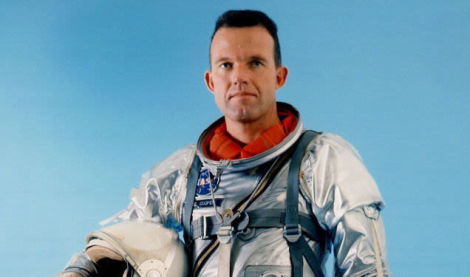
October 4, 2004 – The death of Gordon Cooper. Born on March 6, 1927 in Shawnee, Oklahoma, Leroy Gordon “Gordo” Cooper was an aerospace engineer, US Air Force pilot and test pilot. Cooper flew F-84 Thunderjets and F-86 Sabres in Germany and served as a flight commander in the 525th Fighter Bomber Squadron before becoming the youngest of the Mercury Seven, America’s first astronauts. Cooper first flew in space on May 15, 1963 on Mercury-Atlas 9, the sixth and final manned mission of Project Mercury and the final mission in which a single American astronaut was launched into orbit. During the flight, problems with the guidance system required Cooper to fly the Faith 7 capsule manually, and he came down in the ocean just four miles from the recovery fleet. Cooper’s 34-hour flight marked the first time an American had spent more than a day, and slept, in space. In 1965, Cooper returned to space as Command Pilot of Gemini 5 with Pete Conrad, a 191-hour flight that proved astronauts could fly to the Moon and back. Passed over for an Apollo mission, Cooper retired from NASA in 1970, and died of Parkinson’s Disease at age 77.
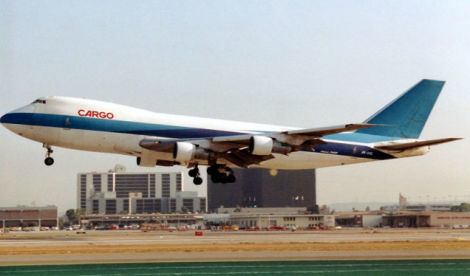
October 4, 1992 – The crash of El Al Flight 1862, a cargo flight from New York’s John F. Kennedy International Airport to Ben Gurion Airport in Israel. After departing from a refueling stop at Amsterdam’s Schiphol Airport, fatigued fuse pins holding the number 3 engine on the Boeing 747-258B/SF (4X-AXG) failed, causing the engine to fall and swing into the number 4 engine. Both engines subsequently broke off the aircraft. The pilots attempted to return to Schiphol, but the asymmetric lift caused by the remaining engines on the left wing, combined with a lack of lift from damaged control surfaces on the right wing, led to an uncontrollable spin as the aircraft slowed for landing. The 747 crashed nose down into an apartment block, causing the deaths of the four crewmembers and 39 on the ground.
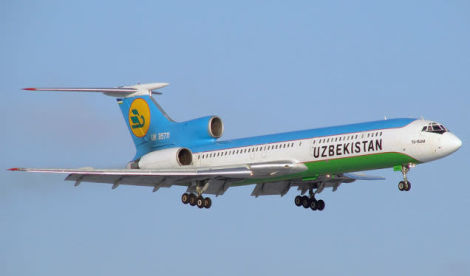
October 4, 1968 – The first flight of the Tupolev Tu-154, a three-engine narrow-body airliner that served airlines of 17 nations and was the mainstay of the Russian flag carrier airline Aeroflot. Since its introduction in 1972, the Tu-154 has carried 137.5 million passengers a year, half of all civilian passengers flown by Aeroflot. Like many other Soviet aircraft, the Tu-154 was designed to operate from unpaved airfields, and provided service to otherwise unreachable Arctic regions of the Soviet Union. Aeroflot announced the retirement of the Tu-154 in 2010 after almost 40 years of service, and the last scheduled passenger flight took place in May 2015.
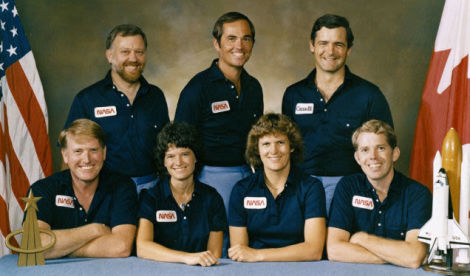
October 5, 1984 – The launch of Space Shuttle Challenger on STS-41-G. The Space Shuttle program tallied many firsts during its 34 years of spaceflights, not the least of which was the first launch and return of a reusable spacecraft and the flight of Sally Ride, the first American woman in space. But STS-41-G had its own impressive list of firsts, some important, some rather mundane. The main goal of the mission was to deliver the Earth Radiation Budget Satellite into orbit, but Challenger also carried the largest crew of any mission with seven astronauts. It was the first time that two women went to space (Ride and Kathryn Sullivan), and Sullivan was the first woman astronaut to perform a space walk (EVA). Also among the crew were Paul Scully-Power, the first Australian-born astronaut, and Marc Garneau, the first Canadian astronaut. And, topping it off, Scully-Power was the first astronaut with a beard.
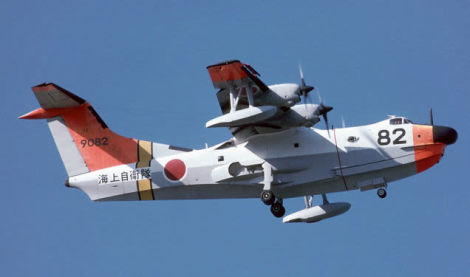
October 5, 1967 – The first flight of the Shin Meiwa US-1A, a large, amphibious short takeoff and landing (STOL) flying boat developed from the Shin Meiwa PS-1 and used by the Japan Maritime Self-Defense Force for maritime patrol, anti-submarine warfare (ASW) and search and rescue (SAR). The hull of the US-1A is based on a refinement of the the Grumman HU-16 Albatross hull design, and a special boundary layer control system helps to reduce the takeoff distance. In 23 years of service, the US-1A and her crews have reportedly saved 550 lives.
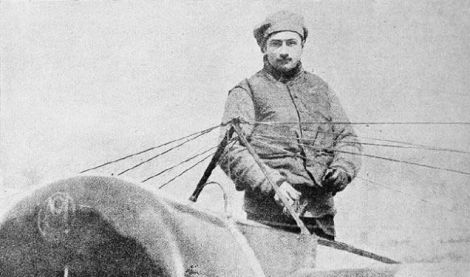
October 5, 1918 – The death of Roland Garros. Born on October 6, 1888, Eugène Adrien Roland Georges Garros was a French aviation pioneer who competed in air races and set a world altitude record of 18,410 ft in 1911. During WWI, Garros helped develop a system of bullet deflectors that allowed gunnery through the propeller and, on August 3, 1914, Garros shot down a German Zeppelin and received credit for history’s first aerial victory. Garros was shot down and killed just one day short of his 30th birthday, five weeks before the Armistice that ended WWI. Despite his lasting fame, though, Garros was not officially an ace, having downed four aircraft during the war, one short of the five necessary for acedom.

October 5, 1914 – The first air-to-air combat victory against another airplane is recorded when a Voisin III pusher biplane of Escadrille VB24, piloted by Sgt. Joseph Frantz with observer Cpl. Louis Quénault, shot down a German Aviatik B.IIover Reims, France. Frantz fired nearly 100 rounds from his Hotchkiss machine gun, while the German observer returned fire with his rifle. After running out of ammunition, the French observer continued firing with his rifle, and the German plane crashed, killing both crewmen.
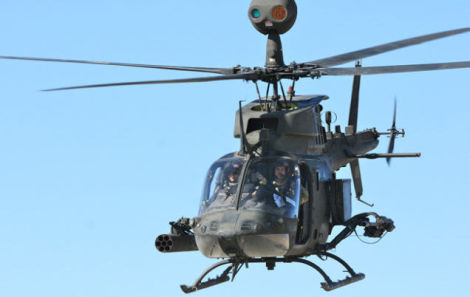
October 6, 1983 – The first flight of the Bell OH-58D Kiowa Warrior. The OH-58 Kiowa is a development of the civilian Bell Model 206 JetRanger and entered service in 1969 in response to an Army requirement for a light observation helicopter (LOH). The OH-58D Kiowa Warrior variant was a product of the Advanced Helicopter Improvement Program (AHIP) which included improved radar for nap-of-the-earth flight, a quieter four-bladed rotor, and a mast-mounted sight (MMS) for locating targets from behind the cover of terrain. The OH-58D is fitted with pylons that can hold two Hellfire missiles, seven rockets, two air-to-air Stinger missiles or one fixed .50 caliber machine gun.
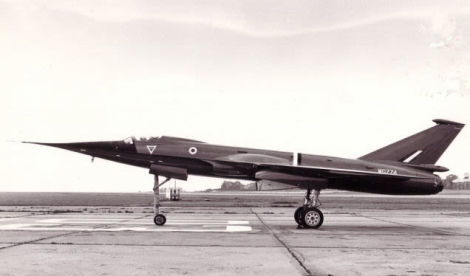
October 6, 1954 – The first flight of the Fairey Delta 2, a British research aircraft that was developed to explore the regimes of transonic and supersonic flight. The Fairey Delta 2 was powered by a single Rolls-Royce Avon 200 axial flow jet engine and was the first aircraft to exceed 1,000 mph, a world speed record that it held for more than a year before being surpassed by the McDonnell F-101 Voodoo. The Delta 2 was also the first British aircraft to have all of its flight surfaces hydraulically controlled. Two prototypes were built, and one was significantly modified to become the BAC 221 which was used for high-speed delta wing testing as part of the development of the Concorde supersonic transport.
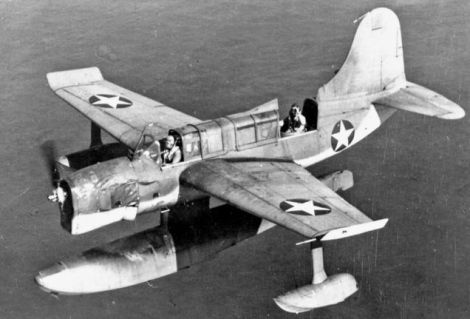
October 6, 1939 – The first flight of the Curtiss SO3C Seamew, a monoplane seaplane designed for the US Navy to replace the SOC Seagull. Per the US Navy requirement, the Seamew could be equipped with either floats or landing gear. To address stability problems, the wingtips were curved upward, and the vertical stabilizer extended across the observer’s cockpit. Due to unresolved problems with the Ranger V-770 inline V-12 engine, the Seamew was withdrawn from frontline units in 1944 in favor of the older biplanes it was meant to replace. Nearly 800 Seamews were built, and the type was retired in 1945.
Connecting Flights
If you enjoy these Aviation History posts, please let me know in the comments. You can find more posts about aviation history, aviators, and aviation oddities at Wingspan.
